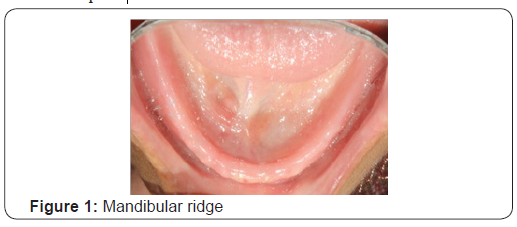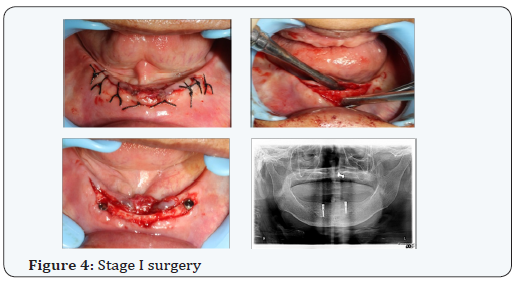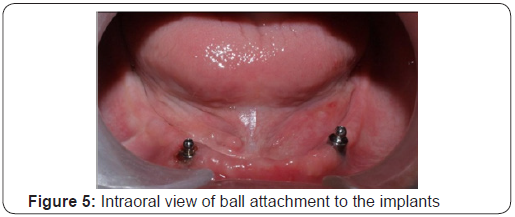Prosthetic Rehabilitation of the Edentulous Mandible with two-Implants Retained Overdenture Using Ball Attachments: A Case Report- Juniper Publishers
Juniper Publishers - Open Access Journal of Dentistry & Oral Health
Abstract
Edentulous patients have been treated with
conventional complete maxillary and mandibular dentures as a primary
treatment modality. Suitable complete maxillary dentures are usually
well tolerated but many patients struggle to chew and swallow with the
complete mandibular denture because it is too unstable. Previous studies
have shown that a mandibular two-implant retained overdenture is
superior to conventional denture in terms of retention and stability.
Thereby, the two-implant assisted mandibular overdenture should be the
first treatment option for mandibular edentulous patients. In this
report, a mandibular two-implant retained overdenture with ball
attachments using direct intraoral pick-up technique is discussed.
Keywords: Implant Overdenture; Edentulous Mandible; Ball Attachment; Healing AbutmentIntroduction
Rehabilitation with conventional maxillary and
mandibular dentures has been well accepted by most of the patients.
However, some patients find dentures problematic due to inadequate
stability and retention. Based on the literature review, mandibular two
implant retained overdentures are considered better option compared to
the conventional mandibular complete dentures [1]. Reford et al. [2]
found 50 % patients with mandibular denture having problems in stability
and retention [2]. Conventional dentures rely upon the residual
alveolar ridge and mucosa for support and retention. In this regard,
rehabilitation by means of implants offers a significant improvement
over conventional prostheses, improving phonetics, esthetics, patient
satisfaction and quality of life [3]. Implant retained overdentures
result in decreased bone resorption, reduced prosthesis movement, better
esthetics, and improved tooth position, better occlusion, including
improved occlusal load direction, increased occlusal function and
maintenance of the occlusal vertical dimension. Studies also proved that
patients wearing implant-supported overdentures exhibit superior
results compared to conventional dentures [4] and enjoy a significantly
higher quality of life compared to conventional denture wearers [5]. The
two-implant retained overdenture, thus, should be the first treatment
choice for mandibular edentulous patients [5,6]. In this case, we
delivered a mandibular implant-retained overdenture with ball
attachments by using intraoral pick-up technique.
Case Report
A 55-year-old female patient reported to the
Department of Prosthodontics, CODS, and BPKIHS with the chief complaint
of loose lower complete denture prosthesis. She had been using the
current set of dentures for the past 6 months and had difficulty in
eating and speaking properly as the lower denture was ill fitting. She
gave a history of losing her teeth 5 years back due to caries and
periodontal disease. Extra oral examination revealed class III facial
profile and a prognathic jaw relationship according to Angle’s
classification. Intraoral examination revealed U shaped ridges which
were smooth without any irregularities, bony spicules or root pieces.
The maxillary ridge was favorable for conventional denture construction,
but the mandibular ridge was found to be resorbed (Atwood’s class IV)
(Figure1). The diagnostic casts were made; a panoramic radiograph
(Figure 2) was taken to assess the bone for suitable selection of
implants. Radiographic examination of the patient showed that the
patient had dense compact bone in the mandibular anterior region without
any pathological findings (Figure 3). The treatment plan of maxillary
conventional complete denture with mandibular two-implant retained
overdenture was explained to the patient.
The patient was convinced and hence, accepted the new
treatment plan.



Chair-side tissue conditioner (Lynal®, Dentsply Caulk, U.S.A.)
and Unifast® self cured resin occlusal reline were performed
to improve the tissue adaptation and the occlusion of the old
dentures. The relined mandibular denture was duplicated to
make a surgical stent for one stage implant placement. In stage
one surgery two implants (3.5 × 11.5) (Adin Dental Implant
System Ltd; Afula, Israel) were placed in the anterior mandible
at B and D region (Figure 4). Sutures were placed and the patient
was recalled after one week. After one week sutures were
removed and the existing mandibular denture was delivered as a
temporary prosthesis during the healing phase.

A second stage surgery was carried out to place healing
abutments 3 months after the primary implant surgery. Healing abutments were fastened to the implants to allow soft tissue
healing without any disturbance. After 1-week ball attachments
were attached with the implants (Figure 5).

Impression of the mandibular arch with ball attachment
was made using closed technique and poured with dental stone
(Kalstone, Kalabhai Karson Pvt. Ltd, India).The attachments
were placed and O rings were blocked-out on the abutments.
The intaglio surface of the mandibular denture was relieved to
provide space for the o-ring attachments. Pressure indicating
paste (Mizzy Prestige Dental Products) was used to verify
the absence of contact of the denture base with abutment or
attachment. A standard chair side auto polymerizing resin mix
was then prepared and placed into the denture. Denture was
placed and the patient was asked to close in function over the
implants with the o-rings attached. Denture was removed from
the patient’s mouth just before final set. The excess acrylic
material was removed and the denture was replaced back to
final set. Insertion of final denture was done (Figure 6).The
patient was instructed with the insertion and maintenance of
the dentures after occlusal adjustment and the verification of
soft tissue adaptation. The patient was trained to use the new
set of dentures, and was satisfied with good stability and greater
degree of retention of them mandibular denture in comparison
to the previous one.

Discussion
The treatment involving two independent implants without
rigid interconnection is an important consideration with regard
to the mandibular overdenture treatment. When using implant
in position B and D, the anterior movement of the prosthesis is
markedly reduced and the prosthesis may also act as a splint for
the two implants during anterior biting forces. There is some
degree of stress reduction in each implant due to this factor.
Factors like the psychological feeling of a removable appliance,
the need for frequent attachment change, the need for relining
and prosthesis movement come to play while putting the
disadvantages into consideration .
OD 1 is used as a treatment option, when patients understand
that additional implant support is beneficial but financial
constraints require a transition period of few years before
placing additional implants. It is reported that ball attachment
are less costly, less technique sensitive [7], and easier to clean
than bars [8] and less wear or fracture of the component takes
place than gold alloy bars [9]. Moreover, the potential for mucosal
hyperplasia is significantly reduced with ball attachments [10].
It was also reported that the use of the ball attachment may be
advantageous for implant-supported overdentures with regard
to optimizing stress and minimizing denture movement [11].
The approach of using ball attachments with healing abutments
as supporting structure in this report has an advantage of being
incorporated at the chair side.
Previous series studies conducted by McGill University
revealed that the implant retained mandibular overdenture is
superior to conventional denture not only in overall satisfaction,
chewing satisfaction, nutritional status, eating and social activity,
but also easier to fabricate. Moreover, the implant retained
mandibular overdenture is a cost-effective intervention. In
consistency with the McGill group, we have similar improvement
in patient outcomes and ease in the fabrication procedures.
Conclusion
The standard treatment of the edentulous patient has
no doubt for many years, been a conventional Complete
Denture. Many CD wearers have significant problems in
adapting to their mandibular prosthesis compared to the
maxillary one. As presented in the clinical report, the patient
benefited tremendously from the mandibular implant-retained
overdenture. The greater degree of patient satisfaction has also
been taken into account and the fabrication procedure being
easier is a major advantage in this treatment option. Therefore,
the two implant-retained overdentures should be considered as
the first treatment option for mandibular edentulous patients.
For more Open Access Journals in Juniper Publishers please click on: https://juniperpublishers.com
For more articles in Open Access Journal of Dentistry & Oral Health please click on:


Comments
Post a Comment